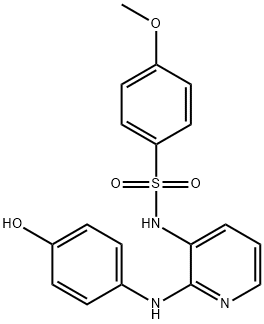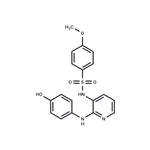Description
ABT-751 is a tubulin polymerization inhibitor that binds to the colchicine binding site on β-tubulin (K
i = 3.3 μM). It inhibits tubulin polymerization in a concentration-dependent manner and inhibits growth of 26 human tumor cell lines (IC
50s = 0.06-0.08 μg/ml). ABT-751 (100 mg/kg, p.o.) induces tumor regression in NB-1382 neuroblastoma, IRS56 rhabdomyosarcoma, and KT-6 Wilms mouse xenograft models. It also induces tumor endothelial cell retraction and reduces tumor perfusion, but not muscle perfusion, in a 9L rat glioma subcutaneous tumor model.
Uses
ABT-751 (E7010) is a novel, highly orally bioavailable sulfonamides antimitotic compound and tubulin binder. It prevents tubulin aggregation by binding to the colchicine site on β-tubulin, leading to cell cycle arrest in G2/M phase and inducing apoptosis, thus effectively preventing cell division. ABT-751 induces autophagy by inhibiting the AKT/MTOR signaling pathway. ABT-751 showed significant inhibition against various types of cancer cells, including lung, gastric, colon, and breast cancer[1][2][3][4][5][6][7][8].
in vivo
ABT-751 (100 mg/kg/day, Oral gavage (p.o.), 5 days on, 5 days off x2, 21 days) has a significant inhibitory effect in neuroblastoma models and can induce significant reduction or regression of tumor volume in rhabdomyosarcoma and nephroblastoma models. ABT-751 has synergistic effect on Vincristine and Paclitaxel (HY-B0015)[7].
ABT-751 (100 mg/kg/day, Oral gavage (p.o.), 5 days on, 5 days off x2) has a synergistic effect on Docetaxel (HY-B0011) in prostate, NSCLC, and breast tumor xenografts in mice. Improve the inhibitory effect on tumor[8].
| Animal Model: | xenograft models of neuroblastoma, osteosarcoma, Ewing sarcoma rhabdomyosarcoma, medulloblastoma and eight kidney cancer lines (six Wilms tumors, two rhabdoid)[7] |
| Dosage: | 100 mg/kg |
| Administration: | Oral gavage (p.o.) |
| Result: | Had obvious inhibitory effect in neuroblastoma model.
Induced significant reduction or regression of tumor volume in rhabdomyosarcoma and nephroblastoma models.
Had a synergistic effect on vincristine or Paclitaxel (HY-B0015).
|
| Animal Model: | PC-3 prostate, Calu-6 NSCLC, and breast MDA-MB-468 tumor xenografts in mice[7] |
| Dosage: | 75, 100 mg/kg |
| Administration: | Oral gavage (p.o.) |
| Result: | 与 Docetaxel 具有协同作用,提高对肿瘤的抑制作用。 |
References
[1] Huang SM et al.,Tankyrase inhibition stabilizes axin and antagonizes Wnt signalling., Nature. 2009 Oct 1;461(7264):614-20. DOI:
10.1038/nature08356[2] Elizabeth Fox et al. A Phase I Study of ABT-751, an Orally Bioavailable Tubulin Inhibitor, Administered Daily for 21 Days Every 28 Days in Pediatric Patients with Solid Tumors Clin Cancer Res February 15, 2008 14; 1111
[3] Aggarwal C, et al. Antiangiogenic agents in the management of non-small cell lung cancer: where do we stand now and where are we headed?,Cancer Biol Ther. 2012 Mar;13(5):247-63. DOI:
10.4161/cbt.19594[4] Silver M, Rusk A, Phillips B, Beck E, Jankowski M, Philibert J, Hahn K, Hershey E, McKeegan E, Bauch J, Krivoshik A, Khanna C.,Evaluation of the oral antimitotic agent (ABT-751) in dogs with lymphoma.,J Vet Intern Med. 2012 Mar-Apr;26(2):349-54. doi: 10.1111/j.1939-1676.2012.00892.x. Epub 2012 Feb 28. DOI:
10.1111/j.1939-1676.2012.00892.x[5] Gaynon PS, Harned TM; for the Therapeutic Advances in Childhood LeukemiaLymphoma (TACL) Consortium. DOI:
10.1097/MPH.0b013e3182532446[6] Morton CL, et al. Evaluation of ABT-751 against childhood cancer models in vivo. Invest New Drugs. 2007;25(4):285-295. DOI:
10.1007/s10637-007-9042-y[7] David Frost, et al. ABT-751, an oral antimitotic, shows additive and synergistic activity with docetaxel in preclinical models. Cancer Res 1 May 2007; 67 (9_Supplement): 1426.
[8] Yoshimatsu K, et al. Mechanism of action of E7010, an orally active sulfonamide antitumor agent: inhibition of mitosis by binding to the colchicine site of tubulin. Cancer Res. 1997;57(15):3208-3213. PMID:9242451





